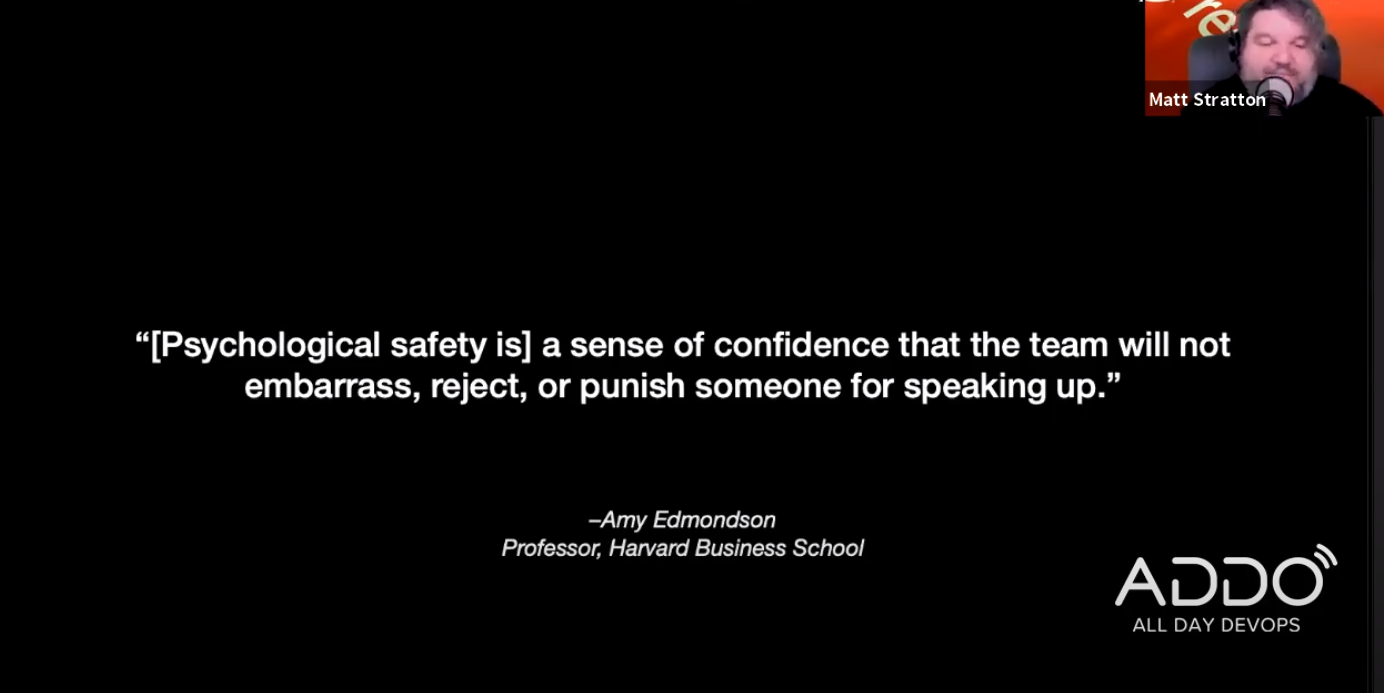We hear “collaboration” and “breaking down silos” a lot with DevOps. We often follow it up with terms like “empathy,” but how do we actually apply empathy?
Matt Stratton, a transformation specialist at Red Hat and host of the “Arrested DevOps” podcast, understands that collaboration is central to effective DevOps teams. In “You’ve Convinced Me We Have to Collaborate—But How the Hell Do We Deal With People?,” Stratton answers how DevOps teams can actually collaborate well.
DORA Leads the WayOne leader in figuring out how to effectively apply empathy when collaborating is DORA and the 2019 State of the DevOps report. They pursued how organizations like Google became high-performing. Do they have some special sauce? Or are there strategies and practices we can repeat at other organizations? It turns out that Google has a lot of psychological safety, and this is key for ensuring strong collaboration.
Psychological Safety
Although it is a key factor in Google’s success, the term “psychological safety” can be vague. Other companies that wish to model psychological safety in their organization may be unsure of what it entails.
The definition we are going by is this: Psychological safety is a sense of confidence that the team will not punish or embarrass someone for speaking up.

Now, many teams believe they have this. They may say things like “We are all nice around each other.” But that doesn’t necessarily mean the team is psychologically safe. For example, Matt made a sarcastic comment to a longtime friend on his team. While his friend understood it was a joke, that sharp comment signaled to people outside the team that this was potentially a psychologically unsafe team.
Conflict
While we want to avoid making people feel that a team is psychologically unsafe, we also don’t want to avoid conflict. Conflict is necessary for collaboration, but we have to approach it correctly. Sometimes it’s necessary to step back and remind yourself that your teammates want to accomplish the same goal as you do, even though you may differ on the approach.
We want to talk through disagreements as one human to another.

Although we all have differences, as humans, we are more alike than different. Thinking about this during our discourse is a powerful tool to foster empathy.
Blamelessness, Curiosity, and Vulnerability
We also want to replace blame with curiosity. Humans are imperfect, and none of us has all the facts or perfect objectivity. So, if we come in with a curious mindset of “what do I not yet know,” instead of “how do I prove that I’m right,” we create psychological safety.
Sometimes curiosity comes off as vulnerability, and this is actually a good thing. People may think that being vulnerable is exposing weakness. But really it’s showing our humanity. People will be more willing to bring forth their ideas when they know it's OK to not be perfect.
Even though we want curiosity, we are still hardwired to lay blame.

This means we need to facilitate conversations to actively steer away from blame. Here are some tips:
- Encourage people to speak up to ensure that everyone is heard.
- Clarify insights and challenge your team with questions. Questions, especially open-ended ones, often express curiosity.
- Don’t make decisions or take sides as a facilitator. Your job is to guide the conversation, not to solve the problem.
- Try to speak as little as possible. Your job is to let others speak as equally as possible.
De-Escalating Conflict
Despite all our efforts to create a psychologically safe culture, potentially unhealthy conflicts sometimes arise, and we need to bring the conflict to a stop to reset.

This is not about compromising but about letting everyone feel heard. When people feel heard, they will often de-escalate their emotions. The factors to de-escalate, in order, are:
- Observations. Before making judgments, we must observe what each person is doing and saying. We also should understand what they are observing.
- Feelings. From observation, we can extract how people are feeling. An angry arguer is different from a sad arguer.
- Needs. What does each person in the room need from the conversation? People who have strong feelings are often not getting what they need.
- Requests. These are the concrete actions that people would like to be taken. Ask questions like “Would you be willing to…?” This will help people get on the same page.
Conclusion
We know collaboration with empathy is important, but we may not know how to achieve it. We must understand that it is important to create psychological safety in a team where everyone can speak with confidence and without fear of embarrassment. We can do this through blameless curiosity and facilitating conversations that de-escalate conflict. We are wired for blame, and we must actively steer discussions away from it.
This post was written by Mark Henke. Mark has spent over 10 years architecting systems that talk to other systems, doing DevOps before it was cool, and matching software to its business function. Every developer is a leader of something on their team, and he wants to help them see that.
Photo by Kaleidico



.png?width=610&name=J1_ModernCybersecurityBook_Promo%201200x628%20v2@2x%20(1).png)



